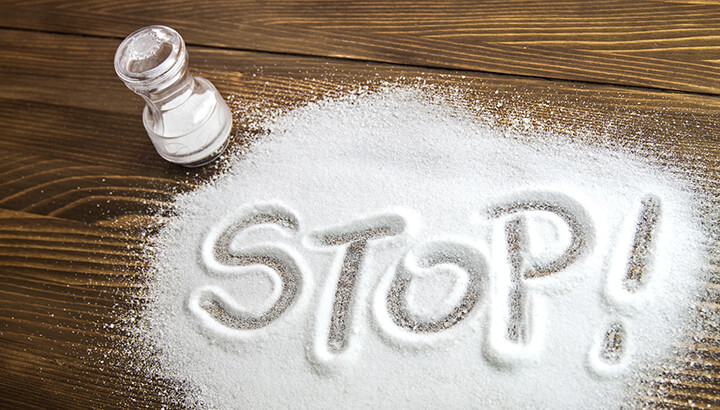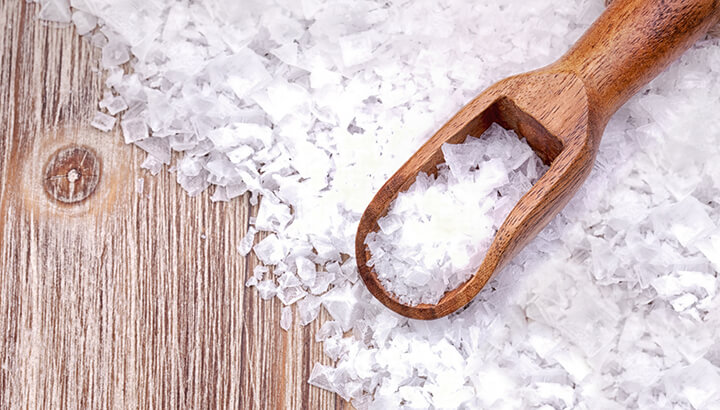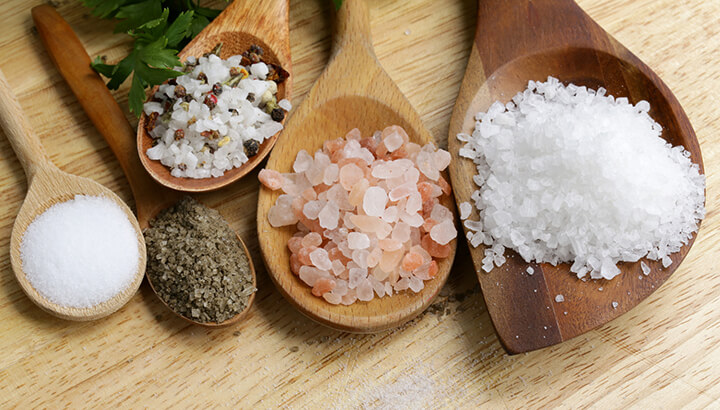Source: https://thealternativedaily.com/7-reasons-drink-warm-salt-water-every-morning/?utm_source=internal&utm_medium=email&utm_campaign=AD240506
7 Reasons to Drink Warm Salt Water Every Day

Have you ever taken a drink of warm salt water in the morning? Unless you take a pre-breakfast swim in a saltwater pool and occasionally swallow an unwanted mouthful, chances are you haven’t.
And while we’re on the topic, have you ever heard of Sole water? If not, that’s okay — lots of people probably haven’t. But it’s time you learned about this amazing, 100-percent natural drink.
Sole water (pronounced so-lay), is not a miracle cure or hip new fad. Rather, it’s a life-supporting mixture of mineral-rich, unrefined salt and water. It supports the body’s natural ability to regulate and heal itself. The term Sole comes from the Latin sol, which means sun.
For years we have been told that salt can be detrimental to our health. The idea of actually drinking salt water may sound more than a touch counter-intuitive. However, a concentrated salt solution made with 100 percent natural salt is healthy and good for your body.
The average American consumes about 10 grams of salt per day, which is predominantly sodium chloride (refined salt) from processed foods. Historically, naturally mined salt played a huge part in the development of civilizations and trade. Salt was once one of the most sought-after commodities. Problems with salt consumption have only come into play with the use of refined table salt and its excessive addition to processed foods.
How refined table salt is made
Unlike unrefined sea salt, table salt has been stripped of its naturally-occurring minerals during processing. To produce your average bag or shaker, large salt producing companies mine poor quality rock salt from the earth, then dry it in large kilns. These kilns heat the salt to temperatures upwards of 1200 degrees Fahrenheit, changing the salt’s chemical structure into pure sodium chloride. This is very different from natural salt, which contains a wide range of trace minerals.
Following this intensive heat-treating process, the resulting salt is now chemically dead. To make the salt edible again, those companies must now add back in a whole host of additives (I know, it makes absolutely no sense, right?). These include fluoride, which we now know to be harmful to our health. The salt also contains synthetic iodine and multiple anti-caking agents.
These anti-caking agents are designed to make the salt more free-flowing (easier to pour), but do so at great cost to your health. Ferrocyanide and silica aluminate are two such additives. Ferrocyanides have been shown to be damaging to our kidneys. They tend to react with certain other common food additives to produce body-wide health problems.
The dangers of refined table salt

Aluminate consumption has been associated with the development of neurological disorders, particularly in the absence of selenium, which would otherwise help the body break it down. Heavy metals like aluminum bio-accumulate in the body, causing the development of further developmental and health disorders.
Not only are these harmful compounds added to table salt after heat treatment, this salt has now had all of its original natural minerals removed. These minerals are a critical part of balancing blood pressure during salt consumption. Meaning, eating table salt causes significant elevations in blood pressure.
High blood pressure, otherwise known as hypertension, can weaken the body’s blood vessels over time. This leads to the development of life-threatening health conditions and complications, including aneurysms, chronic kidney disease, heart attack, stroke, peripheral artery disease and eye damage. A study published in the Journal of Hypertension estimated that just a three-gram reduction in table salt per day could result in a 13 percent lower risk of stroke and a 10 percent lower risk of heart disease.
Finally, have you ever wondered how your table salt is always so pristinely white? That’s certainly not the way nature intended it. Unrefined sea salt or rock salt is never such a perfect shade of white. Table salt is colored white by those mischievous salt companies with the use of bleach. Yup, the same bleach you use to whiten your clothes or kill off stubborn mold or grime in the bathroom.
Yes, natural salt is good for you

The truth is, unrefined salt is actually good for you. It helps to balance blood sugar, keep bones strong, regulate metabolism, boost the immune system and more. Natural salt provides a number of nutrients and minerals in a form the body recognizes and knows how to use.
Naturally filtered salt water gets its vital grayish color from more than 80 trace minerals. Its slight moistness keeps the salt and minerals in a form that the body can utilize effectively.
What happens when natural salt is added to filtered water?
When combined, positive ions in the salt surround the negative ions of the water molecules and vice versa. This creates a new structure that has an electrical charge, which is easily absorbed by the body. Water is no longer water and salt is no longer salt.
Once ingested, the electrical charge in the solution works with the body to send electrical signals between cells and assist the kidneys in maintaining fluid balances.
Drinking a mixture of natural salt and water is nothing new; it has been used as a remedy around the globe for centuries. Both anecdotal and scientific evidence support its use for the following:
1. Hydration
Yes, we are told to drink more water. While most people do need to drink more water, it is possible to drink too much. According to Matt Stone, author of Eat for Heat: A Metabolic Approach to Food and Drink, consuming too much plain water can actually cause the body to become over-diluted.
When this happens, it can put a tremendous strain on the body and slow metabolism. Cellular health is dependent on a particular concentration of minerals and electrolytes. When we drink large amounts of plain water, extracellular fluid becomes diluted, which creates a stress response and the release of adrenaline.
Stone says, “No other creature is so removed from its instinctual programming to the point of accidentally over drinking.” Consuming water with natural salt allows the body to absorb and use the water you are taking in.
Have you ever watered a plant when it is extremely dry? The water just runs out the bottom of the pot. Drinking water all the time is much the same — we just keep on peeing and drinking. A little natural salt and water slows this process down and allows all the goodness of the water to be absorbed and used.
2. Digestion
Salt water begins to activate salivary glands in the mouth, releasing amylase. This initial step in the digestive process is highly important. In the stomach, natural salt stimulates hydrochloric acid and a protein-digesting enzyme, both of which help to break down food.
The role of unrefined, natural salts in stimulating stomach acid cannot be downplayed. The stomach is designed to secrete hydrochloric acid, which kills pathogens such as harmful bacteria, fungi and yeast. It also renders protein as more digestible. People with low stomach acid are therefore unable to digest these proteins, which can remain in the stomach and cause gas, bloating and food allergies.
When undigested food begins to accumulate in an unhealthy stomach, heartburn and reflux occurs. This is because the food sits so long in the stomach that it begins to ferment (gross!). It then produces gases, introduces new strains of potentially harmful yeast into the digestive tract, and creates secondary acids which contribute to heartburn.
When people begin to suffer from these symptoms, their first step is often to reach for the antacids. But as this 2008 study shows, by increasing the stomach’s pH, antacids further interfere with the digestive capacity of the stomach. This leads to a further reduction in digestion of proteins, increases food allergy potential and really just makes the situation a whole lot worse.
The wonder of warm salt water is that it helps to resolve this problem of poor digestion by supporting the stomach’s natural function, rather than impeding it. Just another reason why conventional “health” products often make situations far more complicated that they need to be!
Warm salt water also stimulates secretions in the intestinal tract and liver that help with digestion. Regular consumption of Sole can help with regularity and increase nutrient absorption, as well.
3. Reduced inflammation
The human body’s basic requirement for salt is 1.5 teaspoons or 8 grams per day. If we don’t consume this essential amount of sodium, the body shifts into a “crisis mode” called sodium-sparing so that it can maintain fluid balance and blood pressure. This crisis mode is a critical survival mechanism, but it also has negative consequences.
With low salt intake, an enzyme called renin and a hormone called aldosterone begin to rise rapidly. If this state is prolonged, higher renin and aldosterone levels lead to circulatory damage and increased inflammatory agents in the body.
Researchers have associated a prolonged lack of salt with an increased risk of chronic diseases, such as metabolic syndrome, cardiovascular disease and cognition loss.
4. Better sleep
Salt, especially natural unrefined salt, lowers stress. Stress is arguably the number one biggest cause of lost sleep for the majority of people. Think back to all those nights where you couldn’t get to sleep, your mind racing and your thoughts flitting constantly from one worry to the next. Wasn’t exactly the swift descent into the blissful slumber that you were hoping for, was it?
Warm salt water can actually help with this problem. Research indicates that natural salt has a unique effect on stress levels. As this article published in the Journal of Neuroscience found, increasing the levels of sodium in your bloodstream can reduce stress response. Salt helps to alleviate anxiety and prevents your mind from creating all those worrisome scenarios which keep you up all night.
Not only that, drinking warm salt water can raise your oxytocin levels. Oxytocin is a hormone that helps you to feel calm and relaxed, thereby increasing your sense of well-being. For this reason, one of the best ways to fall asleep faster and sleep deeper during the night is to elevate your oxytocin levels before bed.
To get a better night’s sleep, drink your salt water tonic no more than an hour before bed.
5. Detoxification
Because of the rich minerals, Sole helps the body in its natural detoxification process. Sole is also naturally antibacterial and can help rid the body of dangerous bacteria.
Because many people suffer from poor digestion, their gastrointestinal tract builds up undigested food and waste over time. This waste can slowly ferment in your stomach, small intestine and colon, causing harmful bacteria and other pathogens to grow. These pathogens produce toxins of their own, which in turn continue to accumulate in your worsening digestive system.
Warm salt water is designed to essentially flush out those wastes and toxins by simultaneously cleansing your digestive tract and stimulating rapid bowel movements. This forces all those accumulated wastes out in one fell swoop, leaving you a whole lot less toxic than you were before! A study of 225 elderly patients found that of the subjects who tried a sodium phosphate flush, which is similar to a Sole flush, 91 percent found it effective and would use it again.
6. Bone health
A popular theory regarding osteoporosis and other bone disorders is that the body uses calcium and other minerals from the bones in order to survive and neutralize acidity in the blood. Sole is thought to help improve bone health because it is full of naturally healthy minerals and has an alkalinizing effect.
And if you’ve heard rumors that salt consumption actually causes osteoporosis, think again. A study published in the Journal of Food and Chemical Toxicology concluded that “for the generally healthy person there is no sound evidence that the consumption of salt at the present average level of 9 grams per day constitutes a risk factor for osteoporosis.” And that’s just for normal, nasty table salt. Considering how good natural, unrefined salt is for your body, it’s fair to say that there’s nothing to worry about!
And that’s just for normal, nasty table salt. Considering how good natural, unrefined salt is for your body, it’s fair to say that there’s nothing to worry about!
7. Skin health
Natural salt contains minerals that can help your skin look and feel its best. Chromium fights acne and reduces skin infections. Sulfur keeps skin clean and smooth. It can also help a dry scalp, eczema and rashes that are often a result of a sulfur deficiency. Zinc promotes rapid healing of wounds, boosts the immune system and regulates the activity of oil glands. Iodine helps increase oxygen consumption and the metabolic rate of the skin.
8. Mineral balance
According to Dr. Linus Pauling, two-time Nobel Prize winner, “You can trace every sickness, every disease, and every ailment to a mineral deficiency.” Minerals are the foundation to sound nutrition and health. Without them, no other system in the body works as it should. Amino acids and enzymes don’t work with a lack of vital minerals. Then, our vitamins and other nutrients do not get broken down or absorbed.
Because of our depleted soil and highly refined diet, mineral deficiencies are more common than ever. Sole, made with mineral-rich salt, is a good source of vital minerals. These include barium, bismuth, chromium, magnesium, selenium, zinc, titanium and B2 trace minerals.
Other noted benefits of Sole water
- Improved energy
- Reduced blood sugar
- Healthy veins
- Weight loss
- Reduced muscle cramps
- Reduced blood pressure
How to make Sole salt water
1. Fill a quart-size mason jar one-third full with unrefined, natural salt.
2. Fill the jar with filtered water, leaving two inches at the top.
3. Cover the solution with a plastic (not metal) storage cap.
4. Shake and let it sit for 24 hours.
5. Check in 24 hours to see if all salt crystals are dissolved, and add a little more salt.
6. When the salt no longer dissolves, the Sole is ready.
7. Store covered on a counter or in a cupboard. The antibacterial and antifungal properties of the Sole will help make it last indefinitely.
How to take Sole water
Add half a teaspoon of Sole to an eight-ounce glass of filtered water (this can be warm water) each morning, before breakfast. Taste the Sole — if it tastes salty (like you would expect it to), then it is the perfect amount for you.
If it tastes too salty, dilute with plain, filtered water until it tastes just right. If it does not taste salty enough, add some more Sole until the balance is right. You have to trust your senses on this one — your body knows best! The amount you need may vary each day.
We recommend you consume a whole-foods diet and use natural salt on your food at a level that tastes good. Researchers have found that a healthy ancestral diet results in salt consumption in the range of 1.5 to three tablespoons per day, which coincides with the lowest risk levels for heart disease.
The best natural salt

You can find many kinds of unrefined salt in your local store. Make sure to check the label. Some sea salts are still refined, so it must say “unrefined” on the label. You should look for pink Himalayan salt and Celtic gray sea salt.
We recommend Colima Sea Salt, which is not sold in stores. We know for a fact that it is high-quality, unrefined, and loaded with over 80 healthy minerals and nutrients you need.
And for a very limited time, you can try it for FREE! Claim your FREE Bag of Colima Sea Salt now!
Note: Always consult a health practitioner before beginning any natural health routine.
—Susan Patterson
Related: Sip salt water before bed (flushes fat)
 |
There’s a bizarre salt water trick going viral... Because it’s so simple and easy to do... It’s totally tasteless... And it naturally triggers your body to release belly fat once you fall asleep... Literally helping to flatten your stomach OVERNIGHT!
=> Sip This Before Bed To Flatten Your Tummy Overnight
To good health, Dave |



 Rich in natural minerals like magnesium, potassium, and calcium
Rich in natural minerals like magnesium, potassium, and calcium Free of ocean-borne microplastics and other toxins
Free of ocean-borne microplastics and other toxins Naturally antibacterial
Naturally antibacterial 











